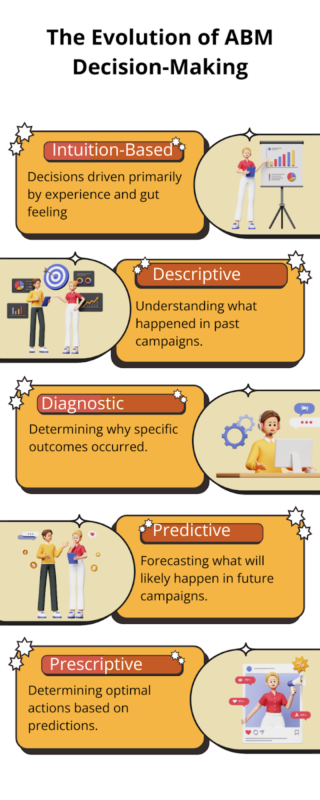Predictive Analytics in LinkedIn ABM: Forecasting Campaign Success with Data
Predictive analytics removes the guesswork from many aspects of an ABM strategy. This technology analyzes patterns and historical data to identify the right accounts. It can also forecast results, identify high-potential opportunities, and optimize resource allocation.
This predictive approach enables more confident decision-making, efficient resource allocation, and superior campaign performance.
How can marketers use predictive analytics to transform LinkedIn ABM from a reactive to a proactive discipline? Continue reading to discover more.
Key Highlights
- Predictive analytics in LinkedIn ABM can improve campaign ROI by up to 35-40% through optimized targeting and resource allocation.
- 97% of marketers report that ABM delivers a higher return on investment than other marketing strategies.
- AI-powered prediction models can forecast account engagement with up to 80% accuracy.
- Multi-dimensional data integration is essential for accurate predictive modeling.
- Propensity modeling identifies accounts most likely to convert before campaigns launch.
- AI-powered tools like Karrot.ai can automate predictive processes and enhance results.
- Continuous learning systems improve prediction accuracy over time.
- Predictive optimization enables real-time campaign adjustments based on forecasted outcomes.
TABLE OF CONTENTS:
Predictive Analytics in LinkedIn ABM
Predictive analytics is the latest trend in ABM AI. This technology boasts accurate targeting, and many of these tools integrate with LinkedIn.
Leaders who use predictive analytics outperform their competitors, experiencing a 73% higher sales lift and a 75% increase in CTRs.
The Evolution of ABM Decision-Making

ABM decision-making has evolved through several stages:
- Intuition-based: Decisions driven primarily by experience and gut feeling.
- Descriptive analytics: Understanding what happened in past campaigns.
- Diagnostic analytics: Determining why specific outcomes occurred.
- Predictive analytics: Forecasting what will likely happen in future campaigns.
- Prescriptive analytics: Determining optimal actions based on predictions.
This improvement stems from the ability to anticipate outcomes and optimize accordingly.
The Predictive Analytics Framework for LinkedIn ABM
While predictive analytics can enhance accuracy and targeting in ABM, this technology is very intricate. Effective predictive analytics requires a structured framework. Follow this advice to truly harness its power.
Data Foundation
Establish a comprehensive data foundation that matches the sophisticated algorithms of predictive analytics. Use this chart as an example:
| Data Category | Examples | Predictive Value |
|---|---|---|
| Account Data | Firmographics, technographics, relationship history | Target selection |
| Engagement Data | Content interactions, website visits, ad responses | Response prediction |
| Campaign Data | Creative performance, channel effectiveness, timing impact | Tactic optimization |
| Conversion Data | Opportunity creation, pipeline progression, close rates | Outcome forecasting |
| External Data | Market trends, competitive activity, economic indicators | Context enrichment |
This data foundation considers all relevant factors, such as which accounts are more inclined to purchase, rather than extracting limited data points.
Predictive Modeling Approach
Implement a structured modeling methodology using predictive analytics, such as this one:
Modeling Process:
– Data Integration and Preparation
– Feature Engineering and Selection
– Model Development and Training
– Validation and Testing
– Deployment and Monitoring
– Continuous Improvement
This approach ensures predictive models are built on sound data science principles rather than simplistic correlations.
Strategy 1: Implement Predictive Account Selection
With predictive analytics, ABM marketers can collect and use data to make more accurate insights into account selection. Here’s why this technology can help you achieve ABM success.
Propensity Modeling
Develop models that predict conversion likelihood, such as these:
- Conversion propensity: Likelihood of becoming a customer.
- Engagement propensity: Likelihood of responding to campaigns.
- Value propensity: Potential deal size and lifetime value.
- Timing propensity: Likelihood of converting within specific timeframes.
- Effort propensity: Resources required for successful conversion.
As a result, ABM marketers can cultivate relationships with the accounts that are likelier to convert. You can create a sophisticated account prioritization model that significantly outperforms intuition-based selection.
Lookalike Modeling
Predictive and lookalike audiences are an effective way for ABM marketers to enhance their reach. With this technology, marketers can identify new high-potential accounts based on existing customers. Here’s how it works:
- Identify seed accounts: Your best customers or highest-value prospects.
- Extract key characteristics: Attributes that distinguish high performers.
- Develop similarity algorithms: Methods for identifying matching patterns.
- Create scoring mechanisms: Approaches for ranking by similarity.
- Implement tiered targeting: Strategies based on similarity scores.
This data-driven expansion approach helps identify high-potential accounts that might be missed through traditional targeting methods.
The Karrot.ai Advantage

Platforms like Karrot.ai enhance predictive account selection and expedite the sales process. Karrot.ai does this through:
- AI-powered pattern recognition that identifies complex indicators of potential.
- Multi-dimensional scoring that considers hundreds of variables.
- Automated prioritization that continuously updates account rankings.
- Segment discovery that identifies high-potential clusters.
- Opportunity sizing that predicts potential value by account.
This AI-enhanced approach enables more sophisticated account selection without requiring in-house data science expertise.
Strategy 2: Forecast Campaign Performance
Predictive analytics helps ABM marketers anticipate audience behavior, forecast trends, and use resources more effectively. Here are more ways that predictive analytics boosts campaign performance.
Performance Prediction Models
Develop models that forecast campaign results with:
- Engagement prediction: Forecasted response rates by segment.
- Conversion prediction: Expected conversion rates at different stages.
- Velocity prediction: Anticipated progression timing through funnel.
- Cost prediction: Projected resource requirements by account.
- ROI prediction: Expected return based on forecasted outcomes.
These prediction models enable more accurate planning and resource allocation, significantly improving overall program efficiency.
Scenario Modeling
Implement “what-if” analysis capabilities for:
- Define variables: Identify factors that can be adjusted.
- Establish relationships: Determine how variables influence outcomes.
- Create simulation models: Build tools for scenario testing.
- Develop comparison frameworks: Methods for evaluating alternatives.
- Implement decision processes: Approaches for selecting optimal scenarios.
This scenario capability enables strategic decision-making based on forecasted outcomes rather than guesswork.
Confidence Interval Analysis
ABM marketers can incorporate uncertainty into predictions by:
- Probability ranges: Likelihood of different outcome levels.
- Confidence scoring: Reliability rating for different predictions.
- Sensitivity analysis: How changes in inputs affect prediction reliability.
- Risk assessment: Potential downside of different scenarios.
- Opportunity sizing: Potential upside of different approaches.
This nuanced approach ensures decisions consider both expected outcomes and the range of possibilities, creating more robust strategies.
Strategy 3: Optimize Creatives and Messaging
Predictive approaches can significantly improve creative performance. Here’s why.
Message Effectiveness Prediction
Here’s how ABM marketers can use predictive analytics to forecast different messaging approaches:
- Theme resonance prediction: Which topics will generate the strongest response?
- Value proposition forecasting: Which benefits will drive the highest engagement?
- Pain point effectiveness modeling: Which challenges will create the strongest connections?
- Tone and style prediction: Which communication approaches will perform best?
- Call-to-action forecasting: Which conversion approaches will drive the highest response?
These predictions enable more confident creative development, focusing resources on approaches with the highest likelihood of success.
Creative Element Optimization
Predict the performance of specific creative elements using these steps:
- Headline performance forecasting: Predict response to different headlines.
- Visual element prediction: Forecast impact of different imagery.
- Format effectiveness modeling: Predict performance of different ad formats.
- Copy length optimization: Forecast impact of varying content approaches.
- Design element prediction: Model response to various design components.
Personalization Impact Forecasting
Predictive analytics can help marketers scale personalization efforts. Marketers can use predictive analytics to target accounts better and predict the value of different personalization approaches using these methods:
- Personalization element forecasting: Which customization approaches will drive response?
- Personalization depth prediction: Optimal level of customization by segment.
- Account-specific customization modeling: Value of individual account personalization.
- Role-based adaptation forecasting: Impact of stakeholder-specific messaging.
- Dynamic element prediction: Which elements should adapt to account data?
Companies that use advanced personalization experience 20% higher conversion rates, so it’s integral to implement these tactics into your ABM campaign.
Strategy 4: Implement Predictive Budget Allocation
Predictive analytics can also improve the way businesses budget for ABM. This data reallocates ad spend toward the accounts with the highest chance of converting. Here are other reasons why resource optimization is a critical application of predictive analytics.
Investment Optimization Models
Predictive analytics find patterns and make predictions about budgeting and revenue. ABM marketers can use this data to make investment optimization models. Here’s how to develop models that optimize resource allocation:
- Account investment forecasting: Optimal spending by account.
- Channel allocation prediction: Ideal budget distribution across channels.
- Timing optimization modeling: Best periods for increased investment.
- Creative investment forecasting: Optimal resource allocation for content.
- Tactic effectiveness prediction: Which approaches deserve a more significant investment?
This optimization approach ensures resources are allocated to the highest-potential opportunities.
Marginal Return Forecasting
Predictive analytics not only forecast sales outcomes but can also predict performance and return. Follow these steps to use this technology for your incremental investments:
- Establish baseline performance: Expected results at current investment levels.
- Model incremental returns: Predicted impact of additional investment.
- Identify diminishing returns thresholds: Points where additional investment yields declining value.
- Compare opportunity costs: Value of investment in different accounts or tactics.
- Create optimization algorithms: Automated approaches to maximize overall return.
This analysis ensures investments are made where they will generate the greatest return rather than simply increasing spending across all activities.
Dynamic Budget Reallocation
For ABM marketers who want to diversify their marketing channels, it’s crucial to implement systems for continuous budget optimization. Here’s how to do this:
- Performance-based reallocation: Shifting resources based on actual vs. predicted results.
- Opportunity-based adjustment: Reallocating based on emerging opportunities.
- Risk mitigation shifting: Adjusting investment to address underperformance.
- Timing-based optimization: Modifying allocation based on temporal factors.
- Competitive response adjustment: Reallocating based on a competitor’s activity.
This dynamic approach ensures budget allocation remains optimal throughout campaign execution rather than remaining fixed despite changing conditions.
Strategy 5: Leverage Predictive Engagement Sequencing
ABM marketers can use predictive analytics to optimize the sequence and timing of engagements. Here’s how to do this for the best results.
Optimal Path Modeling
Follow these tips to predict the most effective engagement sequences:
- Touch pattern forecasting: Which sequences will drive the highest response?
- Channel sequence prediction: Optimal order of channel engagement.
- Content journey modeling: Most effective progression of content types.
- Timing interval forecasting: Ideal spacing between touchpoints.
- Stakeholder sequencing prediction: Optimal order for engaging different roles.
This sequencing optimization ensures accounts experience a personalized journey rather than a predetermined path.
Timing Optimization
Predict the optimal timing for different activities using these methods:
- Day/time effectiveness modeling: Forecast optimal engagement windows.
- Buying cycle alignment prediction: Match activities to purchase process stages.
- Response latency forecasting: Predict time between touchpoints for optimal response.
- Seasonal impact modeling: Account for temporal factors in engagement.
- Trigger-based timing optimization: Predict best timing for event-based activities.
This timing intelligence ensures activities occur when they generate maximum impact rather than based on convenient scheduling.
The Karrot.ai Sequencing Advantage
Platforms like Karrot.ai enhance predictive sequencing through:
- AI-powered journey optimization that identifies ideal engagement patterns
- Automated timing adjustment based on response prediction
- Dynamic sequence modification as account behavior evolves
- Stakeholder-specific journey customization for different roles
- Cross-channel coordination for optimal multi-touch experiences
This AI-enhanced approach enables more sophisticated engagement orchestration without requiring complex manual planning.
Strategy 6: Implement Continuous Learning Systems
Predictive models must continuously improve to maintain accuracy. Here’s how ABM marketers can do this.
Model Performance Monitoring
Implement systematic evaluation of prediction accuracy by using these tactics:
- Prediction vs. actual analysis: Comparing forecasted and actual results.
- Error pattern identification: Recognizing systematic prediction issues.
- Variance tracking: Monitoring consistency of prediction accuracy.
- Segment-specific performance: Evaluating accuracy across different segments.
- Temporal drift analysis: Identifying changes in accuracy over time.
This monitoring ensures campaign issues are quickly identified.
Feedback Loop Implementation
Create systems for continuous model improvement by following these steps:
- Establish performance metrics: Clear measures of prediction accuracy.
- Implement regular evaluation: Systematic assessment of model performance.
- Develop refinement processes: Methods for model improvement.
- Create update protocols: Procedures for implementing model changes.
- Document learning history: Record of model evolution and improvements.
This feedback system ensures models continuously improve rather than degrade over time.
Automated Model Refinement
Leverage automation for model maintenance by implementing these tips:
- Automated retraining: Systematic model updates with new data.
- Feature importance reassessment: Ongoing evaluation of variable significance.
- Algorithmic optimization: Continuous refinement of prediction methods.
- Ensemble model evolution: Development of multiple complementary models.
- Adaptive learning implementation: Models that adjust based on performance.
This automation ensures models remain effective without requiring constant manual intervention.
Case Study: Tech Company Transforms Results with Predictive ABM
A B2B software company implemented comprehensive predictive analytics for their LinkedIn ABM program targeting 1,000 enterprise accounts. Through sophisticated modeling and forecasting, they:
- Developed propensity models that identified the highest-potential accounts.
- Created performance prediction models for different campaign approaches.
- Implemented creative optimization based on message effectiveness forecasting.
- Deployed predictive budget allocation across accounts and tactics.
- Utilized AI-powered engagement sequencing through Karrot.ai.
- Established continuous learning systems for ongoing improvement.
The results demonstrated the power of predictive ABM:
- 42% improvement in target account selection efficiency
- 37% increase in engagement rates across campaigns
- 53% higher conversion rates from MQL to opportunity
- 28% reduction in cost-per-acquisition
- 3.8X return on ad spend (up from 2.2X with traditional approaches)
- $24.3M in influenced pipeline (68% increase from previous results)
Best Practices for Predictive ABM Success
To maximize the effectiveness of predictive analytics in LinkedIn ABM, follow these proven best practices:
- Start with clear objectives that define which ABM goals you want to accomplish
- Implement comprehensive data integration across all relevant sources
- Balance predictive models with interpretability to better identify and engage accounts
- Create templates to automate your ABM processes
- Validate predictions through controlled testing before full implementation
- Combine predictive insights with human judgment rather than relying solely on models
- Implement gradual adoption starting with the highest-impact applications
- Create cross-functional involvement including marketing, sales, and analytics
- Leverage AI-powered tools like Karrot.ai to enable sophisticated prediction without specialized expertise
- Establish regular model evaluation to ensure continued accuracy
- Document and share learnings to build organizational capabilities
- Predictive Analytics in LinkedIn ABM Can Improve Targeting and Engagements
Predictive analytics makes sales forecasting simple. This technology can predict many tactics in an ABM campaign—from account selection and performance prediction to creative optimization and engagement sequencing. This is necessary to improve targeting, engage accounts, and achieve a high ROI.
How can ABM marketers implement predictive analytics in their campaigns? Tools like Karrot.ai offer sophisticated predictions without requiring specialized expertise.
Predictive analytics is evolving ABM programs and can help deliver exceptional results for your business.




